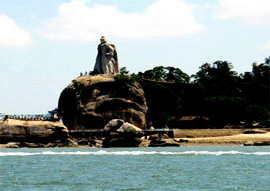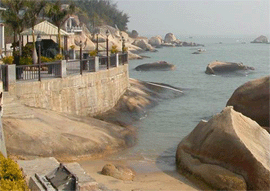Gulangyu Islet, to the southwest of Xiamen Island, covers an area of 1.87 square kilometers. Its rugged  rocks, winding seacoast, undulating green hills and unique workings of Mother Nature create the beautiful and intriguing scenery. The islet's major scenic spots of Sunlight Rock, Shuzhuang Garden, and Haoyue Park are the most prominent tourist attractions. Gulangyu Islet lies in a subtropical marine monsoon climate zone, with plenty of precipitation, four warm seasons, and more than 90 families of over 4,000 varieties of evergreen plants as well as the Piptadenia macrocarpa Benth rarely seen in China, the largest Indian red sandalwood, and many varieties of rare and precious fruit trees transplanted from New Zealand. The is let's vegetation has become the top plant community because of its subtropical oceanic monsoon climate. Gulangyu Islet faces Jinmen (Quemoy) Island across the sea. The area of Xiamen Bay encircling Gulangyu Islet neighbors the Chinese White Dolphins Protected Area, Lancelet Protected Area , and the Dayu Islet Egrets Protected Area. rocks, winding seacoast, undulating green hills and unique workings of Mother Nature create the beautiful and intriguing scenery. The islet's major scenic spots of Sunlight Rock, Shuzhuang Garden, and Haoyue Park are the most prominent tourist attractions. Gulangyu Islet lies in a subtropical marine monsoon climate zone, with plenty of precipitation, four warm seasons, and more than 90 families of over 4,000 varieties of evergreen plants as well as the Piptadenia macrocarpa Benth rarely seen in China, the largest Indian red sandalwood, and many varieties of rare and precious fruit trees transplanted from New Zealand. The is let's vegetation has become the top plant community because of its subtropical oceanic monsoon climate. Gulangyu Islet faces Jinmen (Quemoy) Island across the sea. The area of Xiamen Bay encircling Gulangyu Islet neighbors the Chinese White Dolphins Protected Area, Lancelet Protected Area , and the Dayu Islet Egrets Protected Area.
Prior to the Song Dynasty, Gulangyu was called "Round Sandy Islet" and was overgrown with vegetation and without a trace of human habitation until the end of the Song and early in the Yuan Dynasties when a fishing family surnamed Li settled on opposite Songyu Islet. By the end of the Ming Dynasty the national hero Zheng Chenggong(known abroad as Koxinga) stationed his troops and trained his naval forces on the islet. In 1662, Zheng Chenggong led his troops eastward and recovered Taiwan, which had been occupied by the Dutch for 38 years. After the Opium War, Xiamen was opened as one of the five treaty ports for foreign trade. In 1902, a Municipal Council was elected on Gulangyu, and the islet became an International Settlement and thirteen countries set up consular residences there. During this particular period of time, foreigners and overseas Chinese made unprecedented heavy investments in the construction industry on Gulangyu Islet, resulting in a great variety of  architectural styles and a blending of Chinese and Western cultures, which transformed the densely constructed islet into a "World Architectural Cocktail". architectural styles and a blending of Chinese and Western cultures, which transformed the densely constructed islet into a "World Architectural Cocktail".
In the mid-19th century, with the dissemination of Christianity in China, Western musical culture became a part of Gulangyu Islet's elegant residential environment and created the fine musical tradition that Gulangyu Islet possesses today which has produced a great number of accomplished musicians such as Zhou Shu'an, Lin Junqing, Yin Chengzong, Chen Zuohuang and Xu Feiping. Today, Gulangyu Islet has more pianos per capita than any other places in China, and is home to over 100 families past and present who have been engaged in music, hence the China Musicians' Association decision to nickname Gulangyu as "Music Island".
The islet's relics commemorating historical personages include the unparalleled memorial to the national hero Zheng Chenggong. In spite of weathering over the years, a lot of precious historic stone carvings are still wellpreserved. The islet also has more than 60 personages' residences and mausoleums such as Lin Qiaozhi, founder of China's obstetrics and gynecology; Lu Yizhang, forerunner of Chinese language modernization; Ma Yuehan, China's modern physical culture enlightenment educator, etc. With its graceful natural scenery and rich culture, the islet has become an important national historic interest and tourist attraction, and one of the top 35 scenic areas in China as well as one of the top 10 scenic areas in Fujian Province.
|
